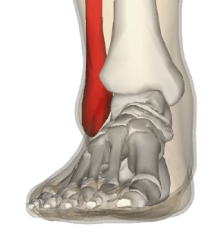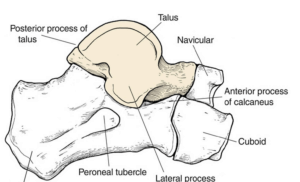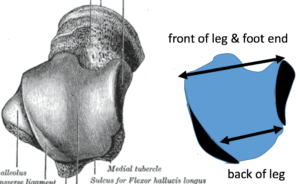The Ankle and Its Role in Walking
A feat of mechanics put down to design

https://health.uconn.edu/orthopedics-sports-medicine/2017/08/12/finding-the-right-running-shoe/
We know two things about ankles. The ankle has a role in walking and secondly, as the song goes, the foot bone is connected to the leg bone. In this article I shall talk about the ankle and its function so you can gain a better understanding why the ankle is such a feat of mechanics!
You look down at your foot in the shoe and see the ankle as two bulges (illustrated) sitting above the edge of the hindpart or quarter in the trainer. It is a curious thing but not all people can wear shoes that cover in the ankle. For me, I prefer to do serious walking in ankle boots. My wife cannot tolerate any ankle covering.
The obvious reason for selecting footwear that protects the ankle is to stop foot and ankle sprains. Sprains will be the subject of the one of my next articles. First we must consider the true ankle joint and explain what is meant by the true ankle joint.
The true ankle joint is the one we all know and moves up and down. The ankle depends on the foot below and using a lower ankle joint, called the sub-talar joint. On top of this there is a third joint which allows even more adaption to the way we walk. It is easy to become confused if we all think the ankle is one joint alone
Reading score for this article = 77
Why do ankles become sprained?
There are two answers.
One is very simple, the other more complex. The simple answer highlights the fact that part of the ankle has greater movement tipping the foot and ankle out so that it leans over too far. The natural braces that prevent damage are weakest on the outside of the ankle.
A more complex response is that there is not one ankle joint but THREE.
Because there is more than one joint the ankle brace system, called ligaments, need to be well developed. Ligaments have to be positioned correctly to take the strain of walking. This takes us to the complex answer and the explanation needs to unfold gently. This article looks at the first of these joints, the true ankle joint.
Relating the foot to the leg via the ankle
Most of us think that the ankle, which I will call the true ankle, is located where those bulges are. The bulges are in fact the ends of the leg bone. This long bone is made of a thick tubular structure. A thinner pipe-like-bone adds to the leg’s strength on the outside.

Red shows the pipe like bone of fibula alongside the tibia.https://en.wikipedia.org/wiki/Fibula#/media/File:Fibula_-_anterior_view.png
You can see from the diagram the bones above the ankle flare out. These prominences are known as malleoli and pronounced mal-ey-oh-lie. From the mechanical viewpoint each leg takes 1/2 the body weight. The ankle sitting closest to the leg bones takes this weight and distributes it to the foot lying underneath. The connecting bone is like the steering wheel of a car. Where the bone goes, so does the foot.

The same picture as above but enlarged to show the close alignment between the talus, foot and long bones of the leg
The most important bone in the foot
Maybe this is a little simplistic, but the foot moves on the bone called the TALUS. The name comes from the Latin word that related to dice used in a Roman craps game. The same bone from a horse was used as the die called a talus.

https://www.hss.edu/condition-list_osteochondral-lesion-talus.asp
This basic shaped bone is rectangular and has a curved top surface. The end of the talus facing the toes has a large connecting dome. This sits in a deep curved bone called the navicular or ‘boat shape’. It is the closest joint to the hip except is does not have the same wide ranging movement. Shapes of bones around joints are important for stability. The diagram shows the bone in red and the dome is not visible because it sits in the navicular (labelled in the second diagram).
In order for the ankle to move, the long tibia and fibular must sit on top snuggly grasping the talus. The foot can move up and down, or the leg can move foreward and backwards on top of the talus when the foot is firmly planted on the ground.

The TALUS shown side on showing its curved top surface allowing main ankle movement. The heel bone sits beneath the talus.

I have selected 2 short YouTube videos. The first lasts for 20 secs and deals only with the movement of the ankle joint (click). There is no sound.
The second video piece lasts 1.25min and shows the main movements of the ankle joint and has oral explanation. The demonstration shows a real foot stripped of all its anatomy except the areas of white. These areas are the ligaments. The Funky Professor is showing true ankle joint movement provided by this one joint only. It carries the name TALO-CRURAL JOINT (TCJ). Talo relates to talus and crural relates to the leg or thigh.
When is the ankle joint strong and when weak?
The Funky Professor makes it clear in his video that there is no other movement than up and downwards. This is true if we want to keep it simple. But, in actual fact there is only a little play in the ankle and this is what causes problems when we walk. Depending upon going upwards or downwards we can soon find our ankle giving way.
The talo-crural joint (the true ankle joint)
When the foot points down, this is called plantar flexion. When it is raised so the toes are close to the leg bones, the movement is called dorsi flexion. When we walk downwards (steps or a hill) the ankle is more unstable than when we walk upwards. This can be explained because the shape of the top surface of the talus is not square. The surface is shaped like a pulley or in Latin trochlea [trok´le-ah]. The illustration below has been taken from talus physiopedia and provides a useful reference. As the ankle joint is moved forward, meaning the leg bones on the ankle bone (talus), the wider trochlear surface ( blue colour) reduces sideways movement. This means the ankle joint is more stable. The black coloured parts are where the two leg bones, fibula and tibia fit. Both are tied together by strong ligaments.
As the leg moves backwards on the ankle, the narrower part makes sideways movement greater. This means the ankle joint is less stable. Going downhill is where we cause ankle sprains or even ankle fractures.

the blue surface (trochlear) is shown wider at the front and narrow at the back (C) Physiopedia
The other ankle joints
As the foot points down (plantar flexion) it points in and as the foot points upwards (dorsi flexion), it faces outwards. However not all of the movement comes from the true ankle joint (TCJ). We need to consider the joint under the talus in order to understand the full picture of why ankles sprain badly or we fracture our ankle. The joint is called the SUBTALAR JOINT (STJ). Now we know that there is an upper talar joint (TCJ) and a lower talar joint (STJ).
This does not explain why we have three ankle joints. The third ankle joint comes from the large round knob of bone in front of the talus which inserts into the navicular. This has the name TALO-NAVICULAR JOINT (TNJ). Both these joints will be dealt with in another article.
In summary
There are three parts to the ankle joint:
The true ankle, the TCJ, the underneath joint called the STJ and the final joint connecting the hind foot to the forefoot known as the TNJ. This simply means to prevent injury you need to be mindful that your weakness is mainly exposed when going downhill.
Read more about the ankle here from ConsultingFootPain
The subtalar joint
The mid tarsal joint from
Ankle sprains
Thanks for reading my series on ‘The ankle and its role in walking’ written by David R Tollafield

Published by Busypencilcase Reflective Communications
Est. 2015
Published 5 January 2020

Sign up to Consultingfootpain today to stay in touch

Recent Comments